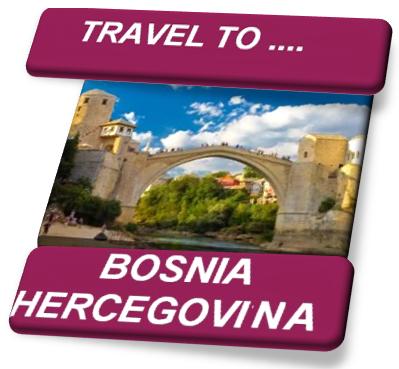3:47 PM Travel to Bosnia Herzegovina |
Bosnia-Herzegovina
However, the country is safe and friendly and extremely cheap to travel around, all of which begins to explain why more and more travellers are choosing to visit. The Balkan state's artistic and historic cultures, its national parks and ancient cities and its breathtaking beauty are just some of the reasons why it is slowly but surely gaining international renown as an excellent holiday destination. Climate
Bosnia's climate is as varied as its terrain and as volatile as its politics. Generally speaking, Southern Bosnia enjoys the climate of Southern Europe – long, hot summers and mild winters, while the mountains spend much of the year under a thick covering of snow and ice. However, storms and high winds can blow across the Balkans at any time of year, and Bosnia is no exception. Indeed, the many factors influencing the weather – that is, Bosnia's geographical features which make and break different weather fronts – contribute to a capricious climate. It's probably sensible to pack sun block and a fleece whatever time of year you're going, and wherever you plan to travel to. Sarajevo in particular can burn you and freeze you in the course of 24 hours, as the mountain peaks force brief and extreme weather fronts over the city. Because of this, there is not really a 'best' time of year to visit the country – Bosnia's springtime wildflowers, hot summers, golden autumns and frozen winters all have their advocates. To give you a sense of what to expect in the short-term, the BBC website has a comprehensive and often accurate five-day forecast for Bosnia-Herzegovina. Things to do and see
Sarajevo is perhaps one of the most fascinating cities in the world, not only for its history and culture but also for its exceptional beauty. Home to the country's impressive national galleries, museums and libraries, Sarajevo also offers eclectic, attractive architecture, great views, great food and great shopping in its several ancient markets. The town still bears the marks of war, and perhaps the best way to get to know it is just to wander around, taking in the atmosphere and the curious mix of ancient and Soviet-era architecture and watching people go about their business. The old town's pavement cafés have great views over the city and to the green hills beyond – from here, it's difficult to believe the dark events of Sarajevo's recent history. In winter, resorts such as Jahorina provide excellent skiing and snowboarding for the lowest prices in Europe, and are near enough to Sarajevo (less than an hour's drive away) to combine a city break with ski holiday – or for the less sporty to escape from the slopes. Mostar is Herzegovina's counterpart to Bosnia's Sarajevo. The ancient bridge, destroyed during the war and rebuilt in 2003, is its most famous landmark. An amazing feat of engineering when it was first built, today it has become a symbol of the country's reunification. Mostar's ancient buildings, markets and narrow streets also attract travellers, and others still use the city as a base for hiking in the beautiful surrounding hills. Further north, adventurous travellers go rafting down rapids near Banja Luka. Indeed, across Bosnia-Herzegovina, it is possible to find small outfits offering hiking tours and watersports wherever available, with new tourist industries literally rising out of the rubble of the war. But the rubble remains – ruined churches, buildings and sometimes whole settlements abound. As this is cleared away bit-by-bit, bits of the country's ancient and recent history goes with it, so even the ruins and remains are worth your attention.
The untouched Bjeslanica hills and mountains in the South offer some of the best, and certainly some of the most remote, hiking in Europe. As well as the wildlife and the scenery, you can pass remote villages such as Lukomir where residents continue a way of life that has long since died out elsewhere. The organic, home grown and home-made food is fantastic, the people friendly and the villages and mountains are beautiful. infohub.com has compiled a non-comprehensive list of walking and hiking tours on offer. Travel
Daily flights to Sarajevo from the UK are increasing, and prices are reasonable. For backpackers on a budget, it might be worth considering flying into Dubrovnik, which is just over the southern border in Croatia, with a bargain airline. You can then take the 5-hour bus journey through southern Bosnia to the capital, or to other destinations within Bosnia, for a few pounds. The scenery is amazing but roads are full of hairpin bends and this is probably not a journey to undertake if you suffer from travel sickness. Accommodation
During the war, the Holiday Inn was the only working hotel in Sarajevo, and it housed all the international journalists in the city. This situation is changing as the infrastructure heals and the tourist population swells. It is easy to find a reasonably priced hotel in any town or city, but many of these are dank and somewhat depressing. It can be worth seeking out a more convivial hostel or even organising an apartment or a home stay, as these options are usually cheaper and often more pleasant than spending a night in a hotel. |
|
|
| Total comments: 0 | |

 The federation of
The federation of